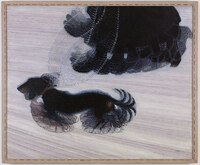Dynamism of a Dog on a Leash
Dublin Core
Title
Dynamism of a Dog on a Leash
Subject
Dynamism of a Dog on a Leash oil painting
Description
The Italian Futurist painter, Giacomo Balla, painted on canvas Dynamism of a Dog on a Leash (1912), a piece that became one of the most recognizable art works from the Futurist movement. The painting portrays a woman walking a dachshund on a leash. The dog’s legs, tail, and long ears as well as the woman’s feet and bottom of her dress are multiplied and painted with different levels of shading to invoke the idea that these components are in rapid motion. This rapid movement is depicted in the painting by the use of multiple brush strokes and blurring around the subjects, which is also a technique used by other Futurist artists called chronophotography. This technique later became the number one way Futurist’s tried to capture movement on canvas (Futurism Movement Overview). Balla took a small excerpt from time, something from everyday life, and painted it as the main focus of this work, something that every person can experience, but made to feel significant. This painting represents one of the main ideas that the Italian Futurists’ championed; that the world is in a constant state of motion. As noted in the Futurist Painting: Technical Manifesto, "Indeed, all things move, all things run, all things are rapidly changing” (Boccioni 64). The group wanted to advance change and focus on the future and evolution of society, which embraced movement, or dynamism (indicated by the name of the work), as a way to boost these advancements.
Creator
Italian Futurism, Whitney Skidmore
Source
“Futurism Movement Overview.” The Art Story, https://www.theartstory.org/movement/futurism/.
Rainey, Lawrence S., et al. Futurism: An Anthology. Yale University Press, 2009.
Date
1912
Language
English
Type
Image
Collection
Citation
Italian Futurism, Whitney Skidmore, “Dynamism of a Dog on a Leash,” ENGL 3460 -- Literature and Utopia, accessed September 19, 2024, https://mapping-nature.org/3460-fall2021/items/show/30.
